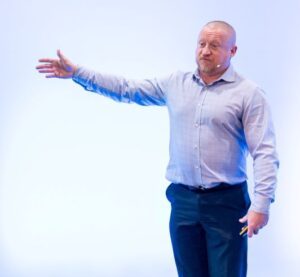Tony Roscoe, Director at Implexis Consulting says managing people in a way that it authentic instead of systematic is the key to driving health and safety from within.

Tony Roscoe, Director at Implexis
The classic line in behavioural safety is that there are three parts to health and safety; the hardware (the guards, barriers, PPE etc), the software (the rules, regulations, procedures etc.) and finally the people.
The trap
Most organisations are best at managing the first two and attempt to engage (I deliberately use engage not empower), mostly because the first two are straight forward and entirely logical and the third (us) is not entirely logical and consequently, much more difficult to manage.
The trap many organisations fall into is to manage the people in the same way that they manage the hardware and software, and we wonder why this does not work.
A good example of this is the how often I come across the term engagement; organisations will often engage the workforce and this is done from an entirely logical perspective (the same approach as hardware and software).
Take for example an employee engagement survey. How many times have you completed one of these surveys and you hear nothing until a year later, when you have to complete another survey?
This is engagement, we asked you your opinion, then ignored the answer (mostly because the survey tells us “what” people think and not “why” they think that way, and it is the “why” that actually tells us how to improve things).
The problem with approaching people in the same way as logical systems is that is not what inspires us, it is certainly not what drives us and we then wonder why we do not get the desired outcome.
Further reading: Hear more from Tony on lessons to learn from failure – Be more dog!
I have seen this so many times when applied in behavioural safety. We approach it as if it is another system or process that involves hardware / software and we miss the people in the middle. I’ve lost count of the number of times I’ve seen organisations that conduct observations that focus on the PPE and forget completely that there is a person wearing that PPE.
So how do we overcome this? Well, I know that the answer is going to be a bit like Marmite, some of you will love it and some will cringe and hate it, but love it or not, it is the answer!
Connection
 If you think of a truly inspirational leader, maybe someone you have worked for or a historical leader, what is it that makes them so inspirational? Connection, they connect with something within you on an emotional level. This is why when we approach people in the same way as hardware or software it fails, because people are inspired by and moved by emotion, not just logic.
If you think of a truly inspirational leader, maybe someone you have worked for or a historical leader, what is it that makes them so inspirational? Connection, they connect with something within you on an emotional level. This is why when we approach people in the same way as hardware or software it fails, because people are inspired by and moved by emotion, not just logic.
In order to understand how we connect with people, I’m going to use the work of Brené Brown, who says that to truly connect with someone we need three things; courage, compassion (empathy) and to be vulnerable.
So let’s look at these three things;
- Courage; it is so much easier as a leader to tell and not to ask. Asking means that we may not like the answer that we get. I’m often asked what is the smallest change that an organisation can make to have the biggest impact on the culture? My answer is always the same, have leaders ask and not tell. When I ask I learn everything, when tell I learn nothing, but being open to the answer you may not like takes courage.
- Compassion / Empathy; feeling with people. Trying to understand the problem or task from the persons perspective. I see this a lot (or at least the lack of it) in incident investigations, when people don’t put themselves in the persons shoes, they never come to the right conclusion. I like the substitution test in Just Culture to help with this. Ask a simple question, under those circumstances, would I have done that?
- Vulnerability; This is often the hardest one for some people, especially “Managers”. I say this in quotes because sometimes people fall into a trap when it comes to leading people. They feel that they have to have all the answers, they don’t they just need to be good at asking questions and making decisions based on that information. It is okay to say “I don’t know” and there is a strength in that. We trust people the most when they have just shown that they are not perfect. Rather than hide our imperfections, we should show them off, be open about them, because people will trust us more. Do you trust someone who thinks they are perfect? I know I don’t.
We have to get away from driving health and safety solely through logic, in the way that we put in place the hardware and software, because this is not what drives people. What drives people is connection and health and safety is not an exception to this, it never has been and it never will be.
The Safety Conversation Podcast: Listen now!
The Safety Conversation with SHP (previously the Safety and Health Podcast) aims to bring you the latest news, insights and legislation updates in the form of interviews, discussions and panel debates from leading figures within the profession.
Find us on Apple Podcasts, Spotify and Google Podcasts, subscribe and join the conversation today!


 If you think of a truly inspirational leader, maybe someone you have worked for or a historical leader, what is it that makes them so inspirational? Connection, they connect with something within you on an emotional level. This is why when we approach people in the same way as hardware or software it fails, because people are inspired by and moved by emotion, not just logic.
If you think of a truly inspirational leader, maybe someone you have worked for or a historical leader, what is it that makes them so inspirational? Connection, they connect with something within you on an emotional level. This is why when we approach people in the same way as hardware or software it fails, because people are inspired by and moved by emotion, not just logic.